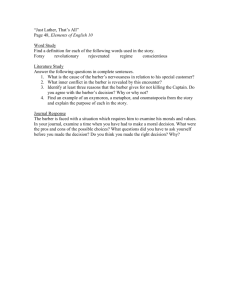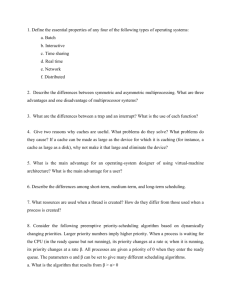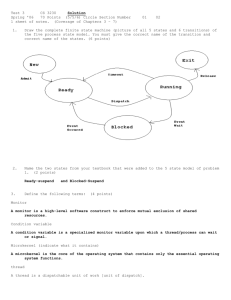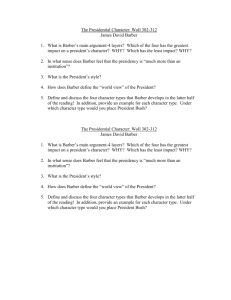Process Synchronization & Deadlocks Roadmap Tevfik Koşar
advertisement
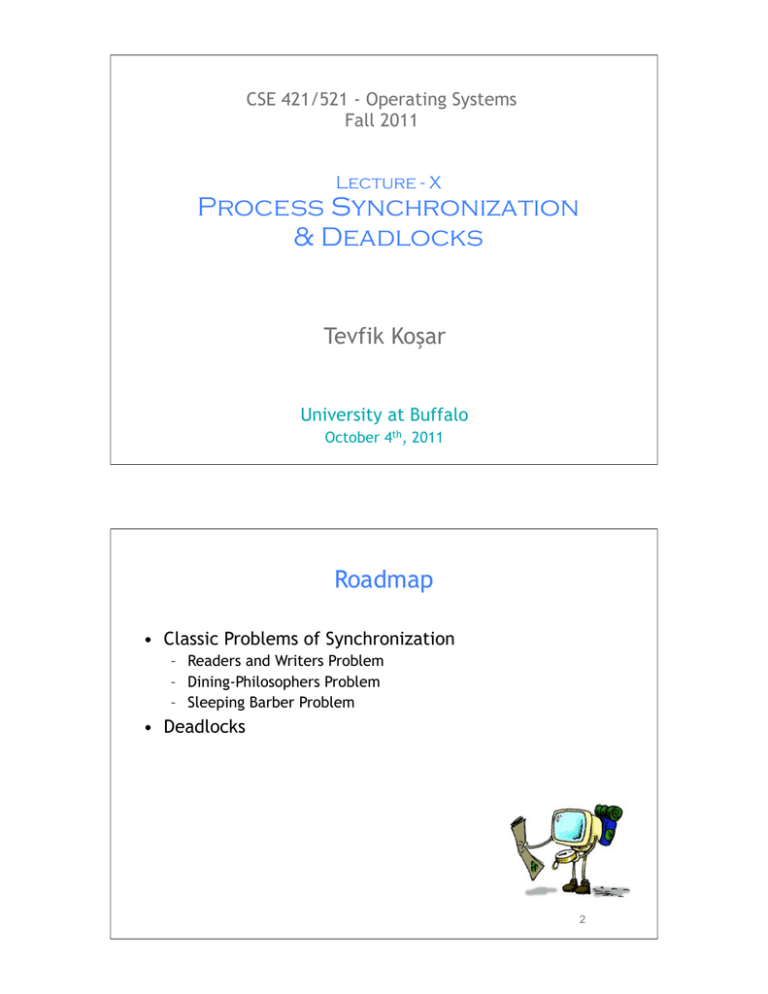
CSE 421/521 - Operating Systems
Fall 2011
Lecture - X
Process Synchronization
& Deadlocks
Tevfik Koşar
University at Buffalo
October 4th, 2011
1
Roadmap
• Classic Problems of Synchronization
– Readers and Writers Problem
– Dining-Philosophers Problem
– Sleeping Barber Problem
• Deadlocks
2
Readers-Writers Problem
•Multiple Readers and writers concurrently accessing
the same database.
•Multiple Readers accessing at the same time --> OK
•When there is a Writer accessing, there should be no
other processes accessing at the same time.
3
Readers-Writers Problem
• The structure of a writer process
do {
wait (wrt) ;
//
writing is performed
signal (wrt) ;
} while (true)
4
Readers-Writers Problem (Cont.)
• The structure of a reader process
do {
wait (mutex) ;
readercount ++ ;
if (readercount == 1) wait (wrt) ;
signal (mutex)
// reading is performed
wait (mutex) ;
readercount - - ;
if readercount == 0) signal (wrt) ;
signal (mutex) ;
} while (true)
5
Dining Philosophers Problem
• Five philosophers spend their time eating and
thinking.
• They are sitting in front of a round table with
spaghetti served.
•There are five plates at the table and five
chopsticks set between the plates.
• Eating the spaghetti requires the use of two
chopsticks which the philosophers pick up one
at a time.
•Philosophers do not talk to each other.
•Semaphore chopstick [5] initialized to 1
6
Dining-Philosophers Problem (Cont.)
• The structure of Philosopher i:
Do {
wait ( chopstick[i] );
wait ( chopStick[ (i + 1) % 5] );
// eat
signal ( chopstick[i] );
signal (chopstick[ (i + 1) % 5] );
// think
} while (true) ;
7
To Prevent Deadlock
• Ensures mutual exclusion, but does not prevent
deadlock
• Allow philosopher to pick up her chopsticks only if both
chopsticks are available (i.e. in critical section)
• Use an asymmetric solution: an odd philosopher picks
up first her left chopstick and then her right chopstick;
and vice versa
8
Problems with Semaphores
• Wrong use of semaphore operations:
– semaphores A and B, initialized to 1
P0
wait (A);
wait (B);
P1
wait(B)
wait(A)
!Deadlock
–
signal (mutex) …. wait (mutex)
! violation of mutual exclusion
–
wait (mutex) … wait (mutex)
!Deadlock
–
Omitting of wait (mutex) or signal (mutex) (or both)
! violation of mutual exclusion or deadlock
9
Semaphores
• inadequate in dealing with deadlocks
• do not protect the programmer from the easy mistakes
of taking a semaphore that is already held by the same
process, and forgetting to release a semaphore that has
been taken
• mostly used in low level code, eg. operating systems
• the trend in programming language development,
though, is towards more structured forms of
synchronization, such as monitors
10
Monitors
• A high-level abstraction that provides a convenient and effective
mechanism for process synchronization
• Only one process may be active within the monitor at a time
monitor monitor-name
{
// shared variable declarations
procedure P1 (…) { …. }
…
procedure Pn (…) {……}
Initialization code ( ….) { … }
…
}
}
• A monitor procedure takes the lock before doing anything else, and
holds it until it either finishes or waits for a condition
11
Monitor - Example
As a simple example, consider a monitor for performing transactions on a bank account.
monitor account {
int balance := 0
function withdraw(int amount) {
if amount < 0 then error "Amount may not be negative"
else if balance < amount then error "Insufficient funds"
else balance := balance - amount
}
function deposit(int amount) {
if amount < 0 then error "Amount may not be negative"
else balance := balance + amount
}
}
12
Condition Variables
• Provide additional synchronization mechanism
• condition x, y;
• Two operations on a condition variable:
– x.wait () – a process invoking this operation is
suspended
– x.signal () – resumes one of processes (if any) that
invoked x.wait ()
If no process suspended, x.signal() operation has no
effect.
13
Solution to Dining Philosophers using Monitors
monitor DP
{
enum { THINKING; HUNGRY, EATING) state [5] ;
condition self [5];
//to delay philosopher when he is
hungry but unable to get chopsticks
initialization_code() {
for (int i = 0; i < 5; i++)
state[i] = THINKING;
}
void pickup (int i) {
state[i] = HUNGRY;
test(i);//only if both neighbors are not eating
if (state[i] != EATING) self [i].wait;
}
14
Solution to Dining Philosophers (cont)
void test (int i) {
if ((state[i] == HUNGRY) &&
(state[(i + 1) % 5] != EATING) &&
(state[(i + 4) % 5] != EATING) ) {
state[i] = EATING ;
self[i].signal () ;
}
}
void putdown (int i) {
state[i] = THINKING;
// test left and right neighbors
test((i + 4) % 5);
test((i + 1) % 5);
}
}
➡ No two philosophers eat at the same time
➡ No deadlock
➡ But starvation can occur!
15
Sleeping Barber Problem
• Based upon a hypothetical barber shop with one barber,
one barber chair, and a number of chairs for waiting
customers
• When there are no customers, the barber sits in his
chair and sleeps
• As soon as a customer arrives, he either awakens the
barber or, if the barber is cutting someone else's hair,
sits down in one of the vacant chairs
• If all of the chairs are occupied, the newly arrived
customer simply leaves
16
Solution
• Use three semaphores: one for any waiting customers, one for the barber
(to see if he is idle), and a mutex
• When a customer arrives, he attempts to acquire the mutex, and waits
until he has succeeded.
• The customer then checks to see if there is an empty chair for him (either
one in the waiting room or the barber chair), and if none of these are
empty, leaves.
• Otherwise the customer takes a seat – thus reducing the number available
(a critical section).
• The customer then signals the barber to awaken through his semaphore,
and the mutex is released to allow other customers (or the barber) the
ability to acquire it.
• If the barber is not free, the customer then waits. The barber sits in a
perpetual waiting loop, being awakened by any waiting customers. Once
he is awoken, he signals the waiting customers through their semaphore,
allowing them to get their hair cut one at a time.
17
Implementation:
+
+
+
+
Semaphore Customers
Semaphore Barber
Semaphore accessSeats (mutex)
int NumberOfFreeSeats
The Barber(Thread):
while(true) //runs in an infinite loop
{
Customers.wait() //tries to acquire a customer - if none is available he's going to
sleep
accessSeats.wait() //at this time he has been awaken -> want to modify the number
of available seats
NumberOfFreeSeats++ //one chair gets free
Barber.signal() // the barber is ready to cut
accessSeats.signal() //we don't need the lock on the chairs anymore //here the
barber is cutting hair
}
18
The Customer(Thread):
while (notCut) //as long as the customer is not cut
{
accessSeats.wait() //tries to get access to the chairs
if (NumberOfFreeSeats>0) { //if there are any free seats
NumberOfFreeSeats -- //sitting down on a chair
Customers.signal() //notify the barber, who's waiting that there is
a customer
accessSeats.signal() // don't need to lock the chairs anymore
Barber.wait() // now it's this customers turn, but wait if the barber
is busy
notCut = false
} else // there are no free seats //tough luck
accessSeats.signal() //but don't forget to release the lock on the
seats }
19
Deadlocks
20
The Deadlock Problem
• A set of blocked processes each holding a resource and
waiting to acquire a resource held by another process
in the set.
• Example
– System has 2 disk drives.
– P1 and P2 each hold one disk drive and each needs another one.
• Example
– semaphores A and B, initialized to 1
P0
wait (A);
wait (B);
P1
wait(B)
wait(A)
21
Bridge Crossing Example
• Traffic only in one direction.
• Each section of a bridge can be viewed as a
resource.
• If a deadlock occurs, it can be resolved if
one car backs up (preempt resources and
rollback).
• Several cars may have to be backed up if a
deadlock occurs.
22
Deadlock vs Starvation
• Deadlock – two or more processes are waiting indefinitely for an
event that can be caused by only one of the waiting processes
• Starvation
– indefinite blocking. A process may never be removed
from the semaphore queue in which it is suspended.
23
Deadlock Characterization
Deadlock can arise if four conditions hold simultaneously.
1. Mutual exclusion: nonshared resources;
only one process at a time can use a specific
resource
2. Hold and wait: a process holding at least
one resource is waiting to acquire additional
resources held by other processes
3. No preemption: a resource can be released
only voluntarily by the process holding it,
after that process has completed its task
24
Deadlock Characterization (cont.)
Deadlock can arise if four conditions hold simultaneously.
4. Circular wait: there exists a set {P0, P1, …,
P0} of waiting processes such that P0 is
waiting for a resource that is held by P1, P1
is waiting for a resource that is held by
P2, …, Pn–1 is waiting for a resource that is
held by
Pn, and Pn is waiting for a resource that is
held by P0.
25
Summary
• Classic Problems of Synchronization
– Readers and Writers Problem
– Dining-Philosophers Problem
– Sleeping Barber Problem
Hmm.
.
• Deadlocks
• Next Lecture: Deadlocks - II
26
Acknowledgements
• “Operating Systems Concepts” book and supplementary
material by A. Silberschatz, P. Galvin and G. Gagne
• “Operating Systems: Internals and Design Principles”
book and supplementary material by W. Stallings
• “Modern Operating Systems” book and supplementary
material by A. Tanenbaum
• R. Doursat and M. Yuksel from UNR
27
